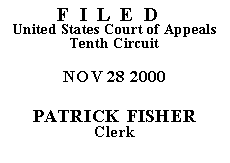 UNITED STATES COURT OF APPEALS
UNITED STATES COURT OF APPEALS
 UNITED STATES COURT OF APPEALS
UNITED STATES COURT OF APPEALS
TENTH CIRCUIT
| UNITED STATES OF AMERICA, | |
| v. | No. 00-3033 |
| CHRISTOPHER FREEMAN, | (D.C. No. 99-20057-01)
(D. Kan.) |
ORDER AND JUDGMENT(*)
Before BALDOCK, HENRY, and LUCERO, Circuit Judges.(**)
A grand jury indicted Defendant Christopher Freeman on thirteen felony counts related to a conspiracy to roll back the odometers of used cars. Pursuant to a plea agreement, Defendant pled guilty to conspiracy, in violation of 18 U.S.C. § 371, knowingly and willfully giving false statements in written disclosures to buyers of used motor vehicles as to the actual mileage of the vehicles, in violation of 49 U.S.C.
§§ 32705(a)(2) & 32709(b), and mail fraud, in violation of 18 U.S.C. §§ 1341 & 1342. In the plea agreement, the Government stated its intent to recommend a two-level enhancement for Defendant's aggravating role in the conspiracy pursuant to U.S.S.G. § 3B1.1(c) (1998). The Government recommended the enhancement based on evidence that Defendant directed at least two criminal participants in the operation. The district court found that a preponderance of the evidence supported the recommended enhancement and imposed a sentence of twenty-seven months. Defendant now appeals. We exercise jurisdiction pursuant to 28 U.S.C. § 1291 and 18 U.S.C. § 3742. When reviewing sentencing decisions pursuant to U.S.S.G. § 3B1.1(c), we review legal conclusions de novo, and factual allegations under a clearly erroneous standard. United States v. Baez-Acuna, 54 F.3d 634, 638 (10th Cir. 1995).(1) Applying this standard, we affirm.
Section 3B1.1(c) allows a two-level sentence enhancement if the defendant was an organizer, leader, manager, or supervisor of one or more participants in any criminal activity. The Sentencing Guidelines define a participant as "a person who is criminally responsible for the offense, but need not have been convicted." U.S.S.G. § 3B1.1, cmt. n.1. Defendant objected to the recommended enhancement arguing the information contained in the presentence report ("PSR") was not sufficient to establish that either of the individuals Defendant allegedly directed were "participants" in Defendant's criminal offense. In response to this objection, the Government presented the testimony of Special Agent Robert Epps who conducted interviews with two of the alleged participants, Mr. Hedrick and Mr. Shearer.
Defendant argues Agent Epps' testimony is unreliable hearsay because statements of co-conspirators are inherently suspect and no other basis exists on which to conclude that Defendant directed or controlled any other "participants" in the offense.(1) We reject this argument because the PSR establishes facts sufficient to support the district court's ruling independent of the testimony at sentencing.
Defendant bears the burden of alleging factual inaccuracies in the PSR. United States v. Deninno, 29 F.3d 572, 580 (10th Cir. 1994). Failure to object to a fact in the PSR acts as an admission. Id. In this case, the PSR contains factual statements sufficient to find Mr. Hedrick and Mr. Shearer are "participants" for purposes of Defendant's sentence enhancement. Specifically, the PSR states that "Mr. Hedrick and Mr. Shearer noticed the mileage on odometers had decreased after they delivered the vehicles to [Defendant]." They both knew they were engaging in an operation that altered odometers but nevertheless continued to participate in the business. Furthermore, the PSR makes it clear that Defendant controlled or directed both Mr. Hedrick and Mr. Shearer. Mr. Shearer would apply for new titles for the vehicles based on fraudulent paperwork prepared by Defendant. The PSR specifically identifies Mr. Hedrick as someone "who worked under [Defendant's] direction." Mr. Hedrick, posing as the person named on the title, sold vehicles for Defendant. Defendant set the minimum price to accept for the vehicle and a sale at a lower price required his approval. Because Defendant never made factual objections to the PSR, these facts must be treated as admitted. Id.
Accordingly, the judgment of the district court is AFFIRMED.
Entered for the Court,
Bobby R. Baldock
Circuit Judge
*. This order and judgment is not binding precedent, except under the doctrines of law of the case, res judicata, and collateral estoppel. The court generally disfavors the citation of orders and judgments; nevertheless, an order and judgment may be cited under the terms and conditions of 10th Cir. R. 36.3.
**. After examining the briefs and appellate record, this panel has determined unanimously to honor the parties' request for a decision on the briefs without oral argument. See Fed. R. App. P. 34(f); 10th Cir. R. 34.1(A)(2). The case is therefore ordered submitted without oral argument.
1. At sentencing, the district court must make specific factual findings before imposing an enhancement based on a defendant's role in the offense. United States v. Wacker, 72 F.3d 1453, 1476 (10th Cir. 1995). In this case, the district court merely announced: "I find that by a preponderance of the evidence on this issue that the § 3B1.1 enhancement is appropriate." We are required, however, to remand only if we believe the district court would not have imposed the same sentence in the absence of the error. See United States v. Lowe, 106 F.3d 1498, 1502 n.8 (10th Cir. 1997) (quoting United States v. O'Dell, 965 F.2d 937, 939 (10th Cir. 1992)). Moreover, Defendant did not question the adequacy of the district court's findings.
1. We admonish Defendant's counsel that the failure to provide the Court with pinpoint cites to the specific propositions in his authority has not gone unnoticed.